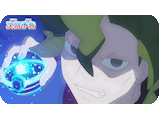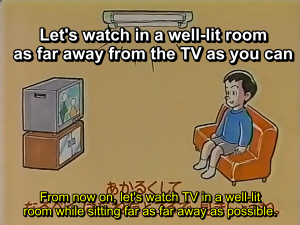
Blog Entry
No. 165



Main
Old Updates Archive
Links
 |
Lists |
List of Pokémon
Pokémon World Atlas
List of Techniques
List
of Items
List of TV Episodes
 |
Guides |
Episode
Comparisons
Movies
& Specials Guide
CD Guide
DVD Guide
Voice
Actors Guide
Lyrics Archive
Manga Guide
Video Games
 |
Miscellaneous |
Humor
Pokémon Bashing
Features
Rants
Dogasu's
Backpack
| Features | Pokémon Shock

| Previous |
Next |

Below is an English
translation of How to Craft
a Story: Takeshi Shudo, How Anyone Can Become a Screenplay Writer (シナリオえーだば創作術 だれでもできる脚本家 首藤剛志), a blog written by former Pocket Monsters series organizer
and head writer Mr. Takeshi Shudo. The following are excerpts taken
from Blog Post No. 165 "The Guidelines that Came About Because of the
Pokémon Incident," a blog entry related to the Pokémon
Shock incident.
One, the Japanese version of the blog is written the way a lot of Japanese blogs are written in that the author only types out (roughly) one sentence per one line. To a native English speaker like me this makes the blogs seem weird and choppy but that's just the way a lot of Japanese blogs are written, for some reason. For simplicity's sake I've replicated this one-sentence-per-line writing style in my English translation.
Two, the following translation is a truncated version of a much, much longer blog entry. Mr. Shudo is an absolute treasure trove of behind-the-scenes information you can't get anywhere else but his blogs are, as far as your average Pokémon fan is concerned, about 80% filler. The writer had a tendency to trail off into some very off-topic tangents in his blog and so what I've decided to do is to pick out the parts that actually discuss the Pokémon Shock incident and present that to you on the page below. I hope you will find this abridged presentation a bit easier to read that it would have been otherwise. If you're someone who would prefer to read an unabridged translation, however, I've also got you covered; you can check those out here.
This blog entry probably talks more about the incident than any of the others! First, he talks about the NHK incident:
Next, he starts to talk about the media's realization that hey, this could have very well happened to any of us.
The show returns to the air:
He then reviews the guidelines set up by the JBA in light of the incident. The official English translation of those guidelines can be found here:
This last part of the blog I'll bring up isn't directly related to Pokémon but I'm including it because it does contain some interesting theories as to why this incident seemed to be as widespread as it was:

Notes about the translation below
I have two notes
about the translations you're about to read.One, the Japanese version of the blog is written the way a lot of Japanese blogs are written in that the author only types out (roughly) one sentence per one line. To a native English speaker like me this makes the blogs seem weird and choppy but that's just the way a lot of Japanese blogs are written, for some reason. For simplicity's sake I've replicated this one-sentence-per-line writing style in my English translation.
Two, the following translation is a truncated version of a much, much longer blog entry. Mr. Shudo is an absolute treasure trove of behind-the-scenes information you can't get anywhere else but his blogs are, as far as your average Pokémon fan is concerned, about 80% filler. The writer had a tendency to trail off into some very off-topic tangents in his blog and so what I've decided to do is to pick out the parts that actually discuss the Pokémon Shock incident and present that to you on the page below. I hope you will find this abridged presentation a bit easier to read that it would have been otherwise. If you're someone who would prefer to read an unabridged translation, however, I've also got you covered; you can check those out here.
| Blog Post No. 165 "The guidelines that
came about because of the Pokémon Incident" |
| Posted November
25th, 2008 |
|
| Original Text
(Japanese) |
Unabridged
Translation |
This blog entry probably talks more about the incident than any of the others! First, he talks about the NHK incident:
| A
similar incident to the one that happened with Pokémon also
happened with a cartoon that aired on NHK, though the number of victims
was much lower. The problem is, it didn't make the news. If we had maybe known about that incident at the time then maybe the episode of Pokémon that caused the issues could have been made with that in mind, and then who knows? Maybe no one would have fallen ill because of Pokémon. But hindsight is 20/20. What happened, happened. |
Next, he starts to talk about the media's realization that hey, this could have very well happened to any of us.
| The
cause of the incident was apparently an animation technique commonly
referred to as "Paka-Paka." They say that viewers who watched scenes using this technique experienced photosensitive epileptic seizures, where strong light stimuli go through the optic nerves and reaches the cerebral cortext, where it induces seizure-causing brain waves. This type of incident could have happened to any cartoon. Actually, scratch that -- bright flashing lights were being used not only in animation, but in TV shows and movies as well, and so this could have very well happened with any of them. Up until then, people saw TV the same way they saw a red traffic light; when you see one you don't think anything bad's going to happen. The mainstream media's bashing of Pokémon started to die down. Animation thought to pose any sort of risk was re-edited, one by one. Since this wasn't just a Pokémon problem, the TV networks linked to the mainstream media realized that hey, this could happen to any of us. And so the mainstream media changed its tune real quick. "Pokémon was just unlucky, that's all." The conversation was starting to go in that direction. But there were also people who said things like: "This is all Pokémon's fault. They're gonna have to pay for this." These people weren't the actual victims of the incident. And they weren't the people who made the Pokémon animated series, either. "We won't be able to use Paka-Paka anymore." This is from a different animation company. The truth is, "Paka-Paka" was a way for animation production to actually cut costs by reducing the number of frames per second while still making exciting images. And so not being able to use "Paka-Paka" meant animation productions had to spend extra money they weren't counting on having to spend. ""Pokémon" didn't do anything wrong. The problem is just with the way it was made. After all, that technique was one that had been used in other animated series at the time." These are the kinds of things the people who made the "Pokémon" animated series started to say. |
The show returns to the air:
| That
Person's biggest dilemma was about to disappear. That Person decided to restart production of the series as soon as he could. The show's viewers had, after all, been raising their voices in favor of the show coming back. But for a short while, at least, "Pokémon" did not air on TV. For the TV network that aired it, "Pokémon" was a very important show. And then there was the movie scheduled to come out the next summer. That Person got antsy and, without waiting for the network's decision, gave the go ahead to restart production. For the first broadcast after the break, they chose the episode "The Pikachu Woods" in which the popular Pokémon Pikachu appeared with lots of its friends. The episode's original title was going to be "It's Been a While, Huh?" The episode that had caused the incident, on the other hand, could not be salvaged and so they decided to just treat it as if it doesn't exist. They never ended up releasing it on VHS or DVD. In the end, "Pokémon" moved from its previous Tuesday slot to a primetime Thursday slot and restarted airing new episodes on April 16th. Despite there being a four month gap in between episodes, ratings for the show's big return weren't all that different from the way they were before the episode that caused the incident. |
He then reviews the guidelines set up by the JBA in light of the incident. The official English translation of those guidelines can be found here:
| The
timing was also pretty good. On April 8th, NHK and The Japan Commercial Broadcasters Association (then known as the National Association of Commercial Broadcasters in Japan, or "NAB") had just released the "Picture Techniques Used in Broadcast Programs." According to those guidelines: 1. As a general rule, the use of lights or images which flash or flicker more than 3 times per second should be avoided. Note also the following: (1) Particular caution should be exercised over the use of deep red color; (2) Where the use of flicker at rates higher than 3 Hz is absolutely necessary, a rate of up to 5 Hz may be used provided that the change in image brightness is less than 20% and that the duration does not exceed 2 seconds. 2. Brightness inversions of high-contrast images, or scene changes in which the image brightness changes by more than 20%, should as a general rule be limited to the rate of 3 Hz. 3. Regular patterns (stripes, spirals, concentric circles, etc.) which occupy a large proportion of the screen should be avoided. Also, in protecting viewers from adverse effects, "the appropriate way to watch TV" also has an important part to play: protective measures include viewing TV in a well-lit room from a distance of at least 2 meters. NAB and NHK will cooperate henceforth in their effort to provide viewers with accurate information about "the appropriate way to watch TV". …is what they came up with. |
This last part of the blog I'll bring up isn't directly related to Pokémon but I'm including it because it does contain some interesting theories as to why this incident seemed to be as widespread as it was:

| It's
been more than 10 years since then. Kids who were 10 years old back then are now 20. That feels like a lifetime ago. That on-screen text that pops up at the beginning of animated shows that say "When watching TV, please make sure to do so in a well-lit room and from a safe distance" are a relic of this incident. Though there are also some networks that don't display those reminders. Personally, I thought over many things at the time in order to come to terms with this incident. When I was a kid, 14 inch TVs were the standard, but now that's been raised to over 20. Nuclear families and declining birth rates meant that a lot of kids are left at home, watching TV by themselves and staring at the screen. If you flip through the channels at around 3 or 4 o'clock in the afternoon you'll come across a bunch of kids' shows. It gradually gets darker as we go from dusk into the night but kids don't seem to notice and just keep watching TV. They keep watching TV, and then right as their eyes are starting to get tired it's time for "Pokémon" to start. …etc., etc. But after the incident, when I happened to be admitted to the same hospital that one of the victims had been taken to, the thought that went through my head was whether or not things are fine the way they are now. The friends and families of the victims and those who were in charge of making "Pokémon" back then will never forget it. Are the guidelines listed out above being followed, even today? Is it OK to treat things like photosensitive epilepsy as a unique condition? How would I know whether or not whether or not I, personally, have a chronic case of photosensitive epilepsy? Do kids actually pay attention to when the sun comes down and make the effort to turn on the lights when it starts to get dark? Even if you sit the recommended two meters away, does that matter given how big TVs have been getting lately? Adults and children' field of visions are different, after all. For a four-year-old, a 29 inch TV is so big it must feel like they're getting sucked into the very picture itself. |
| Previous |
Next |
Found an error or omission? Please help me keep this page current and error-free by e-mailing me with a description of the issue.

